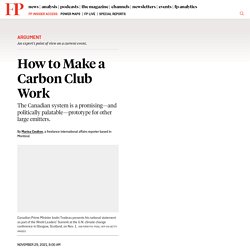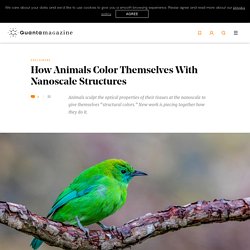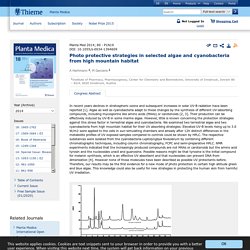

Canada's Carbon Pricing System Is a Model for the World. The United Nations climate change conference in Glasgow, Scotland—known as COP26—closed on Nov. 13 with a new climate agreement: the Glasgow Climate Pact.

The pact reaffirms the global community’s commitment to limiting warming to 1.5 degrees Celsius and includes commitments to reduce methane, end deforestation, and support the countries most impacted by climate change. But like most international agreements, the pact lacks an enforcement mechanism. How Blue Animals Color Themselves With Nanostructures. Other animals exploit similar phenomena in their structural colors.

For instance, one trick behind the color-change artistry of octopuses and other cephalopods is that some of the chromatophore cells in their skin contain layers of proteins called reflectins that can quickly shift from an ordered to a disordered state. By thickening and thinning those layers, the animals can reflect different wavelengths and alter the colors they show the world. Carbon-capturing concrete company is "taking CO2 out of the system" Montreal company Carbicrete has developed a method for sequestering carbon in concrete, claiming its product captures more carbon than it emits.

The technology cuts out the need for calcium-based cement, a key ingredient in traditional concrete that is responsible for around eight per cent of all global CO2 emissions. "It's negative emissions," Carbicrete CEO Chris Stern told Dezeen. "We're taking CO2 out of the system every time we make a block. " Concrete locks carbon away "forever" The company is one of many that is racing to find low-carbon or carbon-free alternatives to traditional concrete but is one of the only ones claiming to have achieved negative carbon.
Chlorophyll f. Chemical compound Chlorophyll f is a type form of chlorophyll that absorbs further in the red (infrared light) than other chlorophylls.[2][3] In 2010, it was reported from stromatolites from Western Australia's Shark Bay.[4] Based on NMR data, optical and mass spectra and density functional theory (DFT) simulation, it is confirmed to have a structure of C55H70O6N4Mg or [2-formyl]-chlorophyll a.[1][2]

Melanin as an Energy Transducer and a Radioprotector in Black Fungi. Scytonemin - an overview. 3.3 Photoprotective Compounds During the last two decades, the use of natural photoprotective compounds has gained much attention considering the safety concerns as several synthetic sunscreen compounds show toxicity and are prone to photodegradation (Serpone et al., 2007).

Cyanobacteria produce a vast array of photoprotective compounds/pigments which are now widely used in the formulation of cosmetics, the sole aim being to reduce the risks of skin cancer and aging. Of these, mycosporine-like amino acids (MAAs), scytonemin, and carotenoids are the most common and reported from several species of cyanobacteria especially those exposed to abiotic stresses including high doses of UV radiation (Rastogi and Sinha, 2009; Gao and Garcia-Pichel, 2011).
Planta Medica. Planta Med 2014; 80 - P1N19DOI: 10.1055/s-0034-1394609 A Hartmann 1, M Ganzera 1 1Institute of Pharmacy, Pharmacognosy, Center for Chemistry and Biomedicine, University of Innsbruck, Innrain 80 – 82/4, 6020 Innsbruck, Austria Congress Abstract In recent years declines in stratospheric ozone and subsequent increases in solar UV-B radiation have been reported [1].

Algae as well as cyanobacteria adapt to these changes by the synthesis of different UV-absorbing compounds, including mycosporine like amino acids (MAAs) or carotenoids [2, 3]. FR radiation. 1608.05322. Scientists Created Materials That Go from Solid to See-Through. Meet the blue crew, scientists trying to give food, flowers, and more a color rarely found in nature. Blue roses are the stuff of poems.

Scientists are trying to make them reality KYOTO, JAPAN—In 2004, Japanese researchers unveiled what they billed as the world's first blue rose. The only problem with the flower: It wasn't very blue.